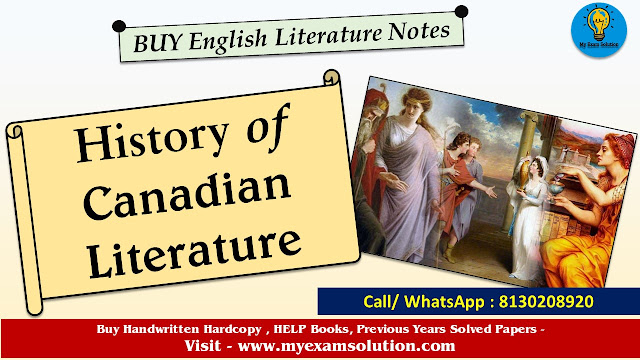History of Canadian Literature and Themes
History of Canadian Literature and Themes :- Canadian Literature Short Summary, Canadian Literature in English pdf, Canadian literature | History, Characteristics, History of Canadian Literature and Themes, Canadian literature has a rich and
diverse history that reflects the multicultural and multilingual nature of the
country. The development of Canadian literature can be broadly categorized into
several distinct periods, each marked by unique social, cultural, and political
contexts. From the early Indigenous oral traditions to the contemporary works
of a multicultural society, Canadian literature has evolved and flourished.
This essay will explore the history of Canadian literature in a chronological
order, highlighting the key developments and influential figures in each
period.
1.
Indigenous Oral Traditions:
The roots of Canadian literature
lie in the rich oral traditions of the Indigenous peoples who inhabited the
land long before European colonization. These diverse cultures had a deep
connection with the land, and their stories, myths, and legends were passed
down orally from generation to generation. These narratives were not only a
form of entertainment but also served as a means of preserving cultural values
and traditions. Examples include the Haida and Inuit oral traditions, which
reflected the unique perspectives and experiences of different Indigenous
groups across the vast Canadian landscape. History of Canadian Literature and Themes
2.
Early European Exploration and Colonization (1600-1763):
The arrival of European explorers
and settlers in the 17th century marked the beginning of a new literary era in
Canada. Initially, much of the literature produced during this period was in
the form of exploration narratives, journals, and religious texts. One notable
figure is Marc Lescarbot, whose work "Histoire de la Nouvelle-France"
(1609) provides insights into early French colonization. However, the dominance
of European voices in literature overshadowed the Indigenous narratives during
this period.
3.
British Colonial Period (1763-1867):
The conquest of New France by the
British in 1763 significantly influenced the literary landscape of Canada. The
gradual influx of English-speaking settlers led to the emergence of a distinct
Canadian identity. Early Canadian literature during this period was often
characterized by a sense of nostalgia for the British homeland. Notable works
include Thomas Chandler Haliburton's "The Clockmaker" series, which
humorously depicted the social and political life of Nova Scotia in the early
19th century. The influence of Romanticism also began to shape Canadian literature,
with writers like Susanna Moodie and Catharine Parr Traill capturing the harsh
realities of pioneer life.
4.
Confederation and National Identity (1867-1914):
The Confederation of Canada in 1867
marked a pivotal moment in the nation's history, and literature played a
crucial role in shaping the emerging Canadian identity. The late 19th and early
20th centuries saw the rise of nationalist sentiments, and writers like Sir
Charles G.D. Roberts and Archibald Lampman contributed to the development of a
distinctly Canadian literary voice. The Confederation poets, also known as the
"Group of Seven," explored themes of nature, nationalism, and a sense
of belonging in their works. This period also witnessed the emergence of
Indigenous voices like Pauline Johnson, challenging the Eurocentric narrative
dominating Canadian literature.
5.
World Wars and Social Change (1914-1960):
The two World Wars had a profound
impact on Canadian society, leading to significant cultural and literary
shifts. The disillusionment and trauma caused by the wars found expression in
the works of writers such as E.J. Pratt and A.M. Klein. The Group of Seven
continued to influence Canadian literature, while new voices like Margaret
Laurence and Sinclair Ross explored the complexities of rural life and
small-town dynamics. The post-war period also witnessed the rise of a more
urban and cosmopolitan literature, with writers like Morley Callaghan and Mavis
Gallant capturing the changing face of Canadian society.
6.
Quiet Revolution and Multiculturalism (1960-1980):
The 1960s marked a period of
significant social and cultural change in Canada, often referred to as the
Quiet Revolution. The province of Quebec experienced a cultural renaissance,
with writers like Michel Tremblay and Hubert Aquin exploring themes of identity
and language. In English Canada, the literary landscape became more diverse
with the advent of multiculturalism. Writers such as Margaret Atwood, Leonard
Cohen, and Alice Munro gained international acclaim during this period. The
exploration of identity, gender, and the environment became central themes in
Canadian literature, reflecting the broader societal shifts.
7.
Contemporary Period (1980-Present):
The late 20th century and the
beginning of the 21st century witnessed a flourishing of Canadian literature
marked by an increasing emphasis on diverse voices and perspectives. Indigenous
writers, including Thomas King, Eden Robinson, and Richard Wagamese, gained
prominence, contributing to a reclamation of Indigenous narratives. The literature
of this period also reflects Canada's growing multiculturalism, with authors
like Rohinton Mistry and Dionne Brand exploring the complexities of diasporic
experiences. The impact of globalization, technological advancements, and the
ongoing dialogue around reconciliation with Indigenous peoples continue to
shape the contemporary Canadian literary landscape.
Conclusion:
The history of Canadian literature
is a narrative of evolution, from the rich oral traditions of Indigenous
peoples to the vibrant and diverse literary scene of the present day. Each
period in this history is marked by unique challenges, influences, and voices
that have contributed to the development of a distinct Canadian literary
identity. As Canada continues to grapple with issues of identity, diversity,
and reconciliation, its literature remains a powerful reflection of the
nation's past, present, and future. History of Canadian Literature and Themes
What are the major themes in Canadian literature?
1. Identity and Belonging:
One of the recurring themes in
Canadian literature is the exploration of identity and the quest for a sense of
belonging. Given Canada's complex history, writers often grapple with the
challenge of defining a national identity that embraces linguistic, regional,
and cultural diversity. This theme is evident in works such as Margaret
Atwood's "The Handmaid's Tale," where societal constructs challenge
individual identity, and in Michael Ondaatje's "In the Skin of a
Lion," which explores the immigrant experience and the construction of
identity against the backdrop of early 20th-century Toronto.
2. Nature and Wilderness:
The vast and awe-inspiring Canadian
landscape is a prominent theme that permeates much of the literature. From the
rugged wilderness of the Rocky Mountains to the serene lakes of the Canadian
Shield, nature is a powerful force that influences characters and narratives.
This theme is vividly depicted in the poetry of Archibald Lampman, part of the
Confederation poets, who celebrated the Canadian landscape and its impact on
the human spirit. Margaret Laurence's "The Diviners" also explores
the connection between the protagonist and the natural world, highlighting the
symbiotic relationship between Canadians and their environment.
3. Multiculturalism and Immigration:
Canada's commitment to
multiculturalism is a theme woven into the fabric of its literature. Authors
such as Rohinton Mistry, in "A Fine Balance," and Joy Kogawa, in
"Obasan," explore the immigrant experience and the challenges of navigating
cultural identities within the Canadian context. The theme extends beyond
first-generation experiences, addressing issues of diversity, inclusion, and
the evolving cultural mosaic that defines modern Canada.
4. Indigenous Perspectives and Reconciliation:
The importance of Indigenous voices
in Canadian literature has grown significantly, contributing to a broader
understanding of the nation's history. Works like Thomas King's "The
Inconvenient Indian" and Eden Robinson's "Monkey Beach" confront
the impact of colonization, residential schools, and the ongoing process of
reconciliation. Indigenous writers bring forth themes of cultural resilience,
connection to the land, and the complexities of identity within the context of
a rapidly changing society.
5. Social Justice and Equality:
Canadian literature has often
served as a platform to address social justice issues and advocate for
equality. Sinclair Ross's "As for Me and My House" delves into the
struggles of a small prairie town during the Great Depression, tackling themes
of poverty and societal expectations. The plays of George F. Walker, such as
"Zastrozzi" and "The End of Civilization," engage with
social issues, offering a satirical lens on the inequalities present in
contemporary society.
6. Tradition and Modernity:
The tension between tradition and
modernity is a recurring motif in Canadian literature, reflecting the nation's
ongoing negotiation with its past and future. This theme is evident in works
like Alice Munro's "Dance of the Happy Shades," where characters
navigate the changing social and cultural landscape of mid-20th-century Canada.
The clash between traditional Indigenous ways of life and modern influences is
explored in Richard Wagamese's "Medicine Walk," illustrating the complexities
of preserving heritage in a rapidly evolving world. History of Canadian Literature and Themes








0 comments:
Note: Only a member of this blog may post a comment.